Zhiyong Yang
Towards Size-invariant Salient Object Detection: A Generic Evaluation and Optimization Approach
Sep 19, 2025Abstract:This paper investigates a fundamental yet underexplored issue in Salient Object Detection (SOD): the size-invariant property for evaluation protocols, particularly in scenarios when multiple salient objects of significantly different sizes appear within a single image. We first present a novel perspective to expose the inherent size sensitivity of existing widely used SOD metrics. Through careful theoretical derivations, we show that the evaluation outcome of an image under current SOD metrics can be essentially decomposed into a sum of several separable terms, with the contribution of each term being directly proportional to its corresponding region size. Consequently, the prediction errors would be dominated by the larger regions, while smaller yet potentially more semantically important objects are often overlooked, leading to biased performance assessments and practical degradation. To address this challenge, a generic Size-Invariant Evaluation (SIEva) framework is proposed. The core idea is to evaluate each separable component individually and then aggregate the results, thereby effectively mitigating the impact of size imbalance across objects. Building upon this, we further develop a dedicated optimization framework (SIOpt), which adheres to the size-invariant principle and significantly enhances the detection of salient objects across a broad range of sizes. Notably, SIOpt is model-agnostic and can be seamlessly integrated with a wide range of SOD backbones. Theoretically, we also present generalization analysis of SOD methods and provide evidence supporting the validity of our new evaluation protocols. Finally, comprehensive experiments speak to the efficacy of our proposed approach. The code is available at https://github.com/Ferry-Li/SI-SOD.
Dual-Stage Reweighted MoE for Long-Tailed Egocentric Mistake Detection
Sep 16, 2025Abstract:In this report, we address the problem of determining whether a user performs an action incorrectly from egocentric video data. To handle the challenges posed by subtle and infrequent mistakes, we propose a Dual-Stage Reweighted Mixture-of-Experts (DR-MoE) framework. In the first stage, features are extracted using a frozen ViViT model and a LoRA-tuned ViViT model, which are combined through a feature-level expert module. In the second stage, three classifiers are trained with different objectives: reweighted cross-entropy to mitigate class imbalance, AUC loss to improve ranking under skewed distributions, and label-aware loss with sharpness-aware minimization to enhance calibration and generalization. Their predictions are fused using a classification-level expert module. The proposed method achieves strong performance, particularly in identifying rare and ambiguous mistake instances. The code is available at https://github.com/boyuh/DR-MoE.
One Image is Worth a Thousand Words: A Usability Preservable Text-Image Collaborative Erasing Framework
May 16, 2025Abstract:Concept erasing has recently emerged as an effective paradigm to prevent text-to-image diffusion models from generating visually undesirable or even harmful content. However, current removal methods heavily rely on manually crafted text prompts, making it challenging to achieve a high erasure (efficacy) while minimizing the impact on other benign concepts (usability). In this paper, we attribute the limitations to the inherent gap between the text and image modalities, which makes it hard to transfer the intricately entangled concept knowledge from text prompts to the image generation process. To address this, we propose a novel solution by directly integrating visual supervision into the erasure process, introducing the first text-image Collaborative Concept Erasing (Co-Erasing) framework. Specifically, Co-Erasing describes the concept jointly by text prompts and the corresponding undesirable images induced by the prompts, and then reduces the generating probability of the target concept through negative guidance. This approach effectively bypasses the knowledge gap between text and image, significantly enhancing erasure efficacy. Additionally, we design a text-guided image concept refinement strategy that directs the model to focus on visual features most relevant to the specified text concept, minimizing disruption to other benign concepts. Finally, comprehensive experiments suggest that Co-Erasing outperforms state-of-the-art erasure approaches significantly with a better trade-off between efficacy and usability. Codes are available at https://github.com/Ferry-Li/Co-Erasing.
MixBridge: Heterogeneous Image-to-Image Backdoor Attack through Mixture of Schrödinger Bridges
May 12, 2025Abstract:This paper focuses on implanting multiple heterogeneous backdoor triggers in bridge-based diffusion models designed for complex and arbitrary input distributions. Existing backdoor formulations mainly address single-attack scenarios and are limited to Gaussian noise input models. To fill this gap, we propose MixBridge, a novel diffusion Schr\"odinger bridge (DSB) framework to cater to arbitrary input distributions (taking I2I tasks as special cases). Beyond this trait, we demonstrate that backdoor triggers can be injected into MixBridge by directly training with poisoned image pairs. This eliminates the need for the cumbersome modifications to stochastic differential equations required in previous studies, providing a flexible tool to study backdoor behavior for bridge models. However, a key question arises: can a single DSB model train multiple backdoor triggers? Unfortunately, our theory shows that when attempting this, the model ends up following the geometric mean of benign and backdoored distributions, leading to performance conflict across backdoor tasks. To overcome this, we propose a Divide-and-Merge strategy to mix different bridges, where models are independently pre-trained for each specific objective (Divide) and then integrated into a unified model (Merge). In addition, a Weight Reallocation Scheme (WRS) is also designed to enhance the stealthiness of MixBridge. Empirical studies across diverse generation tasks speak to the efficacy of MixBridge.
OpenworldAUC: Towards Unified Evaluation and Optimization for Open-world Prompt Tuning
May 08, 2025Abstract:Prompt tuning adapts Vision-Language Models like CLIP to open-world tasks with minimal training costs. In this direction, one typical paradigm evaluates model performance separately on known classes (i.e., base domain) and unseen classes (i.e., new domain). However, real-world scenarios require models to handle inputs without prior domain knowledge. This practical challenge has spurred the development of open-world prompt tuning, which demands a unified evaluation of two stages: 1) detecting whether an input belongs to the base or new domain (P1), and 2) classifying the sample into its correct class (P2). What's more, as domain distributions are generally unknown, a proper metric should be insensitive to varying base/new sample ratios (P3). However, we find that current metrics, including HM, overall accuracy, and AUROC, fail to satisfy these three properties simultaneously. To bridge this gap, we propose OpenworldAUC, a unified metric that jointly assesses detection and classification through pairwise instance comparisons. To optimize OpenworldAUC effectively, we introduce Gated Mixture-of-Prompts (GMoP), which employs domain-specific prompts and a gating mechanism to dynamically balance detection and classification. Theoretical guarantees ensure generalization of GMoP under practical conditions. Experiments on 15 benchmarks in open-world scenarios show GMoP achieves SOTA performance on OpenworldAUC and other metrics. We release the code at https://github.com/huacong/OpenworldAUC
ABKD: Pursuing a Proper Allocation of the Probability Mass in Knowledge Distillation via $α$-$β$-Divergence
May 07, 2025Abstract:Knowledge Distillation (KD) transfers knowledge from a large teacher model to a smaller student model by minimizing the divergence between their output distributions, typically using forward Kullback-Leibler divergence (FKLD) or reverse KLD (RKLD). It has become an effective training paradigm due to the broader supervision information provided by the teacher distribution compared to one-hot labels. We identify that the core challenge in KD lies in balancing two mode-concentration effects: the \textbf{\textit{Hardness-Concentration}} effect, which refers to focusing on modes with large errors, and the \textbf{\textit{Confidence-Concentration}} effect, which refers to focusing on modes with high student confidence. Through an analysis of how probabilities are reassigned during gradient updates, we observe that these two effects are entangled in FKLD and RKLD, but in extreme forms. Specifically, both are too weak in FKLD, causing the student to fail to concentrate on the target class. In contrast, both are too strong in RKLD, causing the student to overly emphasize the target class while ignoring the broader distributional information from the teacher. To address this imbalance, we propose ABKD, a generic framework with $\alpha$-$\beta$-divergence. Our theoretical results show that ABKD offers a smooth interpolation between FKLD and RKLD, achieving an effective trade-off between these effects. Extensive experiments on 17 language/vision datasets with 12 teacher-student settings confirm its efficacy. The code is available at https://github.com/ghwang-s/abkd.
Focal-SAM: Focal Sharpness-Aware Minimization for Long-Tailed Classification
May 03, 2025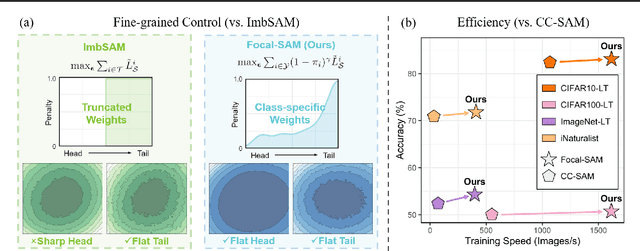

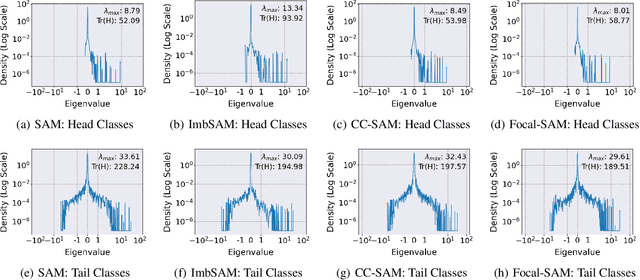
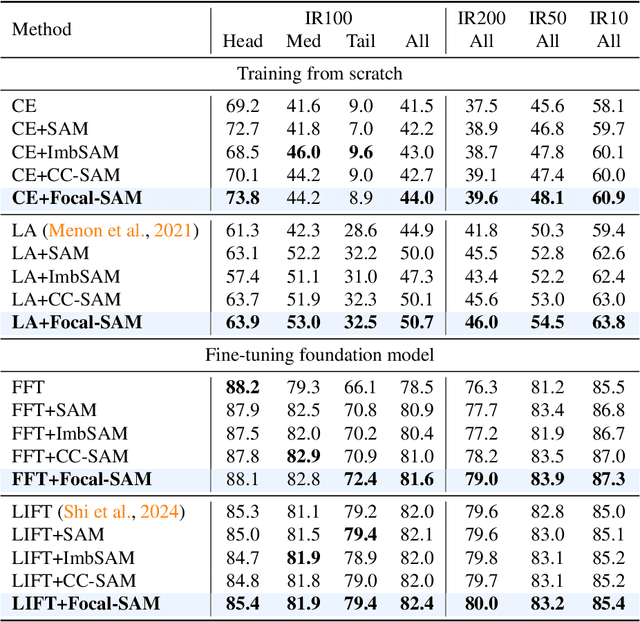
Abstract:Real-world datasets often follow a long-tailed distribution, making generalization to tail classes difficult. Recent methods resorted to long-tail variants of Sharpness-Aware Minimization (SAM), such as ImbSAM and CC-SAM, to improve generalization by flattening the loss landscape. However, these attempts face a trade-off between computational efficiency and control over the loss landscape. On the one hand, ImbSAM is efficient but offers only coarse control as it excludes head classes from the SAM process. On the other hand, CC-SAM provides fine-grained control through class-dependent perturbations but at the cost of efficiency due to multiple backpropagations. Seeing this dilemma, we introduce Focal-SAM, which assigns different penalties to class-wise sharpness, achieving fine-grained control without extra backpropagations, thus maintaining efficiency. Furthermore, we theoretically analyze Focal-SAM's generalization ability and derive a sharper generalization bound. Extensive experiments on both traditional and foundation models validate the effectiveness of Focal-SAM.
SSE-SAM: Balancing Head and Tail Classes Gradually through Stage-Wise SAM
Dec 18, 2024
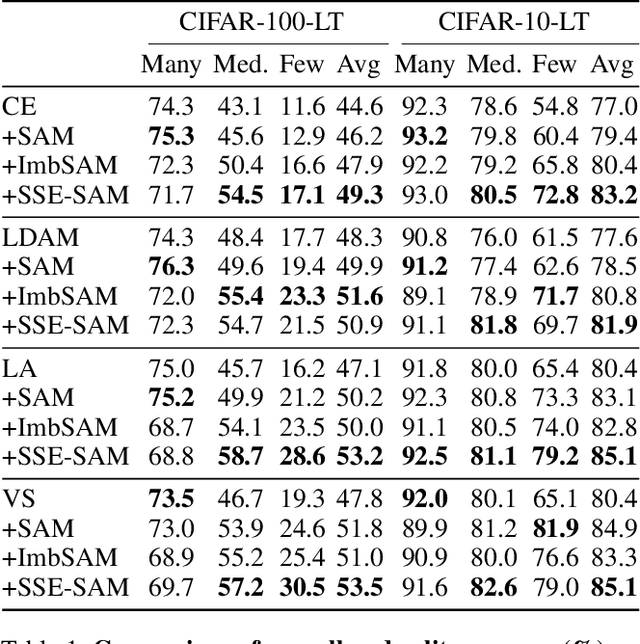
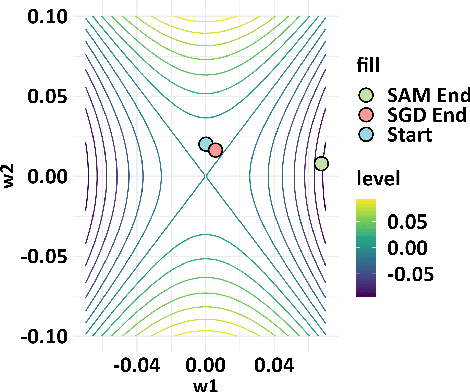
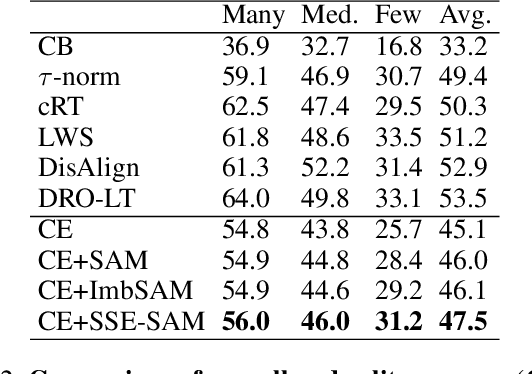
Abstract:Real-world datasets often exhibit a long-tailed distribution, where vast majority of classes known as tail classes have only few samples. Traditional methods tend to overfit on these tail classes. Recently, a new approach called Imbalanced SAM (ImbSAM) is proposed to leverage the generalization benefits of Sharpness-Aware Minimization (SAM) for long-tailed distributions. The main strategy is to merely enhance the smoothness of the loss function for tail classes. However, we argue that improving generalization in long-tail scenarios requires a careful balance between head and tail classes. We show that neither SAM nor ImbSAM alone can fully achieve this balance. For SAM, we prove that although it enhances the model's generalization ability by escaping saddle point in the overall loss landscape, it does not effectively address this for tail-class losses. Conversely, while ImbSAM is more effective at avoiding saddle points in tail classes, the head classes are trained insufficiently, resulting in significant performance drops. Based on these insights, we propose Stage-wise Saddle Escaping SAM (SSE-SAM), which uses complementary strengths of ImbSAM and SAM in a phased approach. Initially, SSE-SAM follows the majority sample to avoid saddle points of the head-class loss. During the later phase, it focuses on tail-classes to help them escape saddle points. Our experiments confirm that SSE-SAM has better ability in escaping saddles both on head and tail classes, and shows performance improvements.
Bidirectional Logits Tree: Pursuing Granularity Reconcilement in Fine-Grained Classification
Dec 17, 2024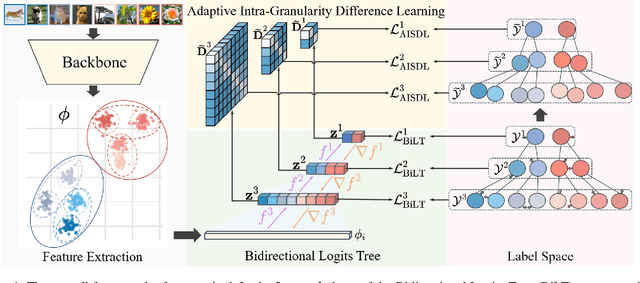

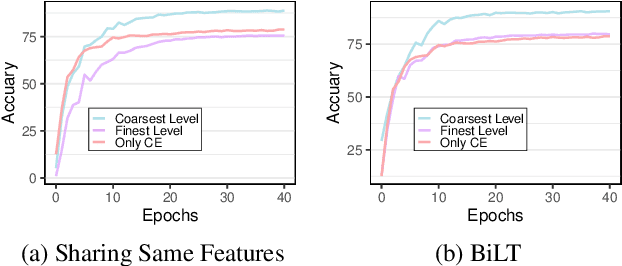

Abstract:This paper addresses the challenge of Granularity Competition in fine-grained classification tasks, which arises due to the semantic gap between multi-granularity labels. Existing approaches typically develop independent hierarchy-aware models based on shared features extracted from a common base encoder. However, because coarse-grained levels are inherently easier to learn than finer ones, the base encoder tends to prioritize coarse feature abstractions, which impedes the learning of fine-grained features. To overcome this challenge, we propose a novel framework called the Bidirectional Logits Tree (BiLT) for Granularity Reconcilement. The key idea is to develop classifiers sequentially from the finest to the coarsest granularities, rather than parallelly constructing a set of classifiers based on the same input features. In this setup, the outputs of finer-grained classifiers serve as inputs for coarser-grained ones, facilitating the flow of hierarchical semantic information across different granularities. On top of this, we further introduce an Adaptive Intra-Granularity Difference Learning (AIGDL) approach to uncover subtle semantic differences between classes within the same granularity. Extensive experiments demonstrate the effectiveness of our proposed method.
EDGE: Unknown-aware Multi-label Learning by Energy Distribution Gap Expansion
Dec 10, 2024Abstract:Multi-label Out-Of-Distribution (OOD) detection aims to discriminate the OOD samples from the multi-label In-Distribution (ID) ones. Compared with its multiclass counterpart, it is crucial to model the joint information among classes. To this end, JointEnergy, which is a representative multi-label OOD inference criterion, summarizes the logits of all the classes. However, we find that JointEnergy can produce an imbalance problem in OOD detection, especially when the model lacks enough discrimination ability. Specifically, we find that the samples only related to minority classes tend to be classified as OOD samples due to the ambiguous energy decision boundary. Besides, imbalanced multi-label learning methods, originally designed for ID ones, would not be suitable for OOD detection scenarios, even producing a serious negative transfer effect. In this paper, we resort to auxiliary outlier exposure (OE) and propose an unknown-aware multi-label learning framework to reshape the uncertainty energy space layout. In this framework, the energy score is separately optimized for tail ID samples and unknown samples, and the energy distribution gap between them is expanded, such that the tail ID samples can have a significantly larger energy score than the OOD ones. What's more, a simple yet effective measure is designed to select more informative OE datasets. Finally, comprehensive experimental results on multiple multi-label and OOD datasets reveal the effectiveness of the proposed method.
 Add to Chrome
Add to Chrome Add to Firefox
Add to Firefox Add to Edge
Add to Edge